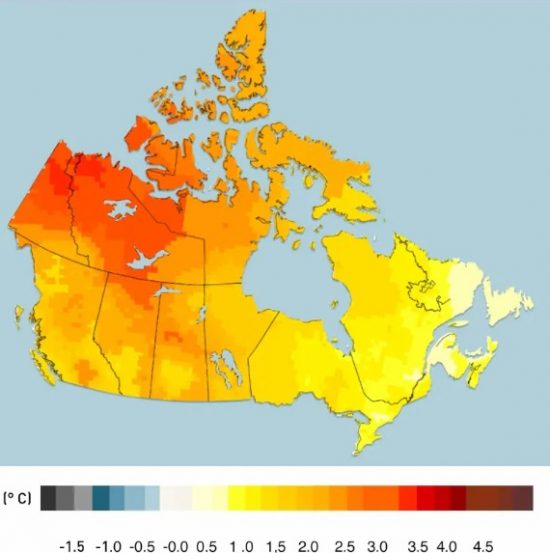
April 2, 2019 – Canada faces atmospheric warming at a rate twice as fast as the rest of the world according to the latest study commissioned by Environment and Climate Change Canada. The mean temperature on average over the entire country has risen 1.7 Celsius since 1948 compared to 0.8 Celsius as a global average. And in the North the mean average has increased by 2.3 Celsius.
What other climate conditions are described in this study?
- the oceans that surround the country are more acidic and less oxygenated than in the past.
- there are more episodes of extreme heat, and less of extreme cold with shorter periods of snow and ice coverage.
- glaciers are thinning.
- permafrost temperatures are rising and there is increased thawing.
- the sea levels of all three oceans are rising with increased rates of coastal flooding.
- growing seasons are lengthening.
- there is less snowfall but more rainfall in much of the country with an increasing percentage of the latter falling in winter months and less falling in the southern part of the country during the summer.
- higher winter river volumes match rising winter precipitation while summer river water volumes are declining.
- Arctic and Atlantic Ocean sea-ice conditions are changing with increased ice-free periods during summer months in the High Arctic.
- hazardous ice conditions are increasing as Arctic sea ice becomes more seasonal than permanent.
In terms of projections, the study looks at both low and high greenhouse gas emission scenarios projecting two very different futures for the country based on “uncertainty about human behaviour .” It is this last statement that I would like to focus on today because we are seeing political expediency driving policy alternatives expressed by some provincial governments, and the federal conservative opposition of the country.
On April 1st, just when Canadians were in the midst of filing taxes, the federal government’s carbon levy was enacted beginning at $20 CDN per ton of carbon emissions. Designed with the expectation that a price on carbon could eventually change Canadian behaviour, the launch has been attacked by Canada’s conservative parties as a job killer, and as federal overreach to take money out of the pockets of average families.
When the carbon levy was first announced it came in two parts. First, there was to be a price on carbon starting at $20 per ton and rising annually by $10 until capped at $50. But second, the government put in place payments to every Canadian to offset the extra cost incurred from the carbon levy. In other words, the scheme was to be revenue neutral, a policy meant to change human consumption of fossil fuels, the primary contributor of greenhouse gas emissions. Over time the idea would be that Canadians would receive these payments and see the advantage in reducing their use of carbon-intensive products and thus avoid the levy.
As a mitigation strategy putting a price on carbon was not new. It first was instituted successfully by the British Columbia provincial government with a similar strategy of offsets to make it revenue neutral. In that province, carbon pricing has not killed jobs and has not taken money out of the pockets of average families. But nevertheless, opposition to a price on carbon exists in a number of provinces led by conservative governments with several launching court challenges to have carbon pricing declared illegal. There is a concerted effort among these provincial governments to work closely with the conservative opposition at the federal level to unseat the government in the upcoming election this fall.
There is no uncertainty in this form of human behaviour. These are governments and political parties that have little interest in truth-telling. They are very much cut from the same cloth as is the Donald Trump regime in the United States. Carbon pricing bad. Coal good. Oil good. Finding more of it good. Discrediting climate science good.
These conservative governments and parties appear to be comfortable with the changes happening to climate in the present and future. Rather than educating the public on mitigation and adaptation, and raising public awareness about what to expect, and how to collectively change these projected outcomes, their interest is in misinformation and defeating the incumbent federal Liberal government.
These conservatives argue that Canada is a small contributor to greenhouse gas emissions globally when compared to China or the United States. So why should we be doing anything at our end if these prime polluters aren’t putting a price on carbon themselves? They argue that the atmosphere has no borders so any carbon mitigation efforts on our part really will not matter that much. So then why not continue to extract, burn and export our fossil fuels, a mere drop in the global bucket? They argue that the cause of climate change is uncertain, that the evidence of human influence on global climate is not proven. They ignore climate science in taking these positions. It doesn’t matter that the last four years of the 21st century have been the warmest on record since we began measuring atmospheric temperatures around the globe in the middle of the 19th century. It doesn’t matter that the reinsurers that underwrite risk for the insurance industry correlate the cost of increased extreme weather event damage to life and property directly with rising atmospheric temperatures and attendant rises in sea levels.
Winning government and discrediting the science behind the policy to price carbon are their goals. And if they can appeal to the pocketbooks of Canadians over the importance of implementing a carbon reduction strategy they are absolutely comfortable with this strategy. What a disservice to the people of Canada and the planet.
In a recent Globe and Mail editorial it asks “Remember when the Liberal carbon tax was a conservative idea?” Apparently, Canada’s conservatives have short memories when it’s only about winning or keeping in power.









